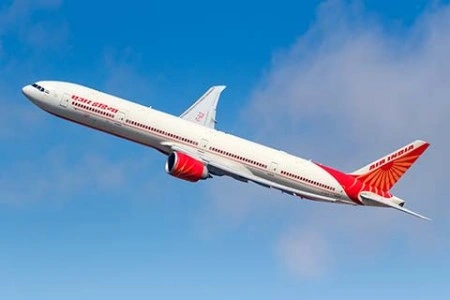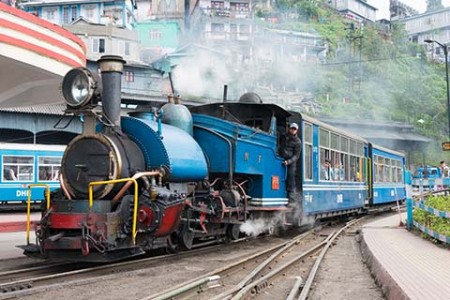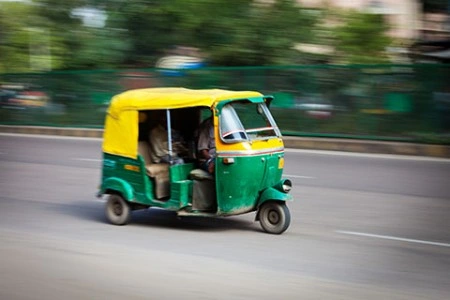"Uncover the Wonders of India: An Overview"
About India
Namasté or Namaskar is an Indian greeting as well as a gesture. Namaskar is considered a slightly more formal version than Namaste, but both express deep respect. The word is spoken at the beginning of written or verbal communication. However, the same hands folded gesture is made wordlessly upon departure. Taken literally, it means "I bow to you". The word is derived from Sanskrit (namas): to bow, obeisance, reverential salutation, and (te): "to you". When spoken to another person, it is commonly accompanied by a slight bow made with hands pressed together, palms touching and fingers pointed upwards, in front of the chest. The gesture can also be performed wordlessly and carry the same meaning.
A country so vast, India represents diversity in all its forms: people, religions, customs and traditions, clothes, dialects, habits. She begins with the highest peaks and descends across mighty fastnesses and rolling pains to submerge in not one but three seas. Beaches surround her coastal belts, and in Rajasthan there is the stillness of the Thar Desert. The great seas, a still desert, the might of the Himalayas… India has all this and more. Backwater canals and tropical forests, rugged hill towns, river estuaries, wooded swamps and glacial meadows. Regions unattainable by road, places unexplored. The suavity of city dwellers contrasts sharply with aboriginal tribes who still lead their sheltered existence unhindered by the spread of civilization. India’s history goes back to 3200 BC when Hinduism was first founded. Buddhism, Jainism, Sikhism, Judaism, Zoroastrianism, Christianity and Islam all exist within the country today of more than 1.3 billion people. Today’s visitors revel in the fantastic breadth of history left by a stream of dynasties and conquerors. British Raj Relics, Portuguese Churches, Rajput Forts, Mughal Palaces, Buddhist Stupas, Jain and Hindu Temples all create an unforgettable, incredible diverse horizon.

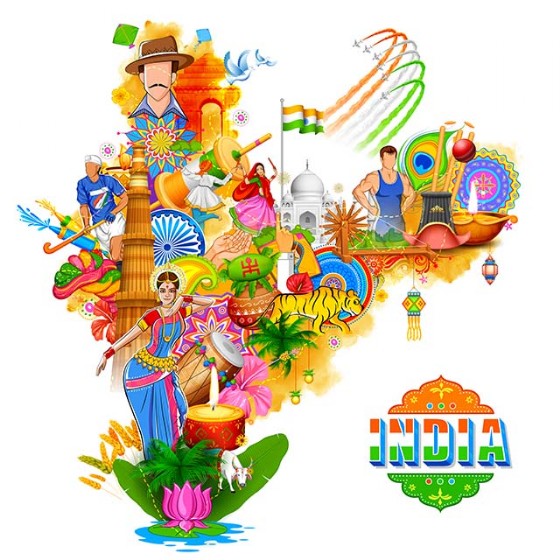
Apart from these cultural landmarks, India’s calendar is studded with extraordinary festivals that offer rare, highly-charged experiences that could be the highlight of our trip. This is the moment when you become more than just a tourist and actually penetrate the living traditions of India and its people.
Indians are considered very hospitable. An Indian welcome is thousands of years old, and the simple aarti ritual that honours all guests as manifestations of God, has been refined over centuries. To the Indian, the country is a harmonious whole which he does not question. To the foreigner, the diversity is a puzzling complexity which he seeks to understand. Come see the dances of India, witness the pageant of its festivals, taste the spirit of its culinary celebrations, or admire objects shaped by hand by master artisans and you will experience some of the cultural mores of a country that boasts a civilisation five thousand years old....
India’s geographical diversity gives it a climate variation few other countries can match. Summer in the Thar desert can be really hot during the day (desert evenings are usually cool), while winter in Ladakh may mean snowing for weeks, a weather that is quite literally freezing. There is little variation in the tropical temperature in the Andaman or Lakshadweep groups of islands, and in Cherrapunji, the heaviest average rainfall in the world has been recorded. Generally, summers in the country are warm, the winters pleasant to cold. It is best to head for the cool hill resorts all over India during the hot summers, though air-conditioned facilities can mean you will not be effected by the heat even in the plains, should you plan a summer holiday in some of the popular historic and cultural destinations of the country.

Cultural Discovery
India’s past is always at hand. From the Taj Mahal in Agra, a 17th century monument, to such discoveries as the Ajanta and Ellora cave paintings and sculptures, from the temples of South India to the palaces and forts of Rajasthan, from British memorials and buildings to Hindu and Islamic monuments, and their medley, every city and town in India is a vivid pageant of history. Like gems that glitter, India’s arts embellish its ancient heritage. Classical dance forms, the cadences of music – both vocal and instrumental, the art of calligraphy, textile weaving, marble inlay, enameling, rug making, crewel embroidery, wood carving, gold and silver smithery… these are but a few examples of the rich treasures that await you.
The Outdoors
The grand Himalayas are the world’s youngest, and also its highest chain of mountains. The Thar desert stretches unrelieved, a monotony of sand. Dense forests, the world’s largest estuary with its mangrove swamps, riverine plateaus and stretching lowlands make up India, an exciting amalgam for those who seek the outdoors, its lakes and rivers, a long coastline (the waters of three seas touch Indian shores), forest trails and the silence of high mountain fastnesses.
It is, therefore, natural, that you can enjoy here too leisure activities linked with the outdoors. Trekking and mountaineering or just camping in the high hills and mountains is an exciting experience. You can also raft the rapids of Himalayan rivers among some of the world’s most challenging waters. Take an option and set off on a camel safari in the desert, or in a hot air balloon, or perhaps try your hand at hang gliding. There’s kayaking too, and canoeing, and of course, para sailing, snorkeling, deep sea diving, or setting off on your own on water scooters. And if you thought that was all, there’s winter skiing too, as well as that ultimate adventure sport – heli skiing!
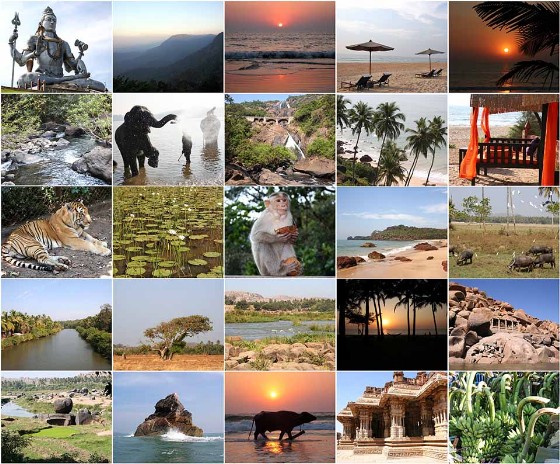
Wildlife
India has a large number of national parks and sanctuaries, most of them fairly easily accessible, with comfortable lodgings. Here, a wealth of wildlife can be sighted: the Indian tiger in all his majesty, rare animals such as the snow leopard, Himalayan tahr, Indian rhinoceros, gaur, thamin deer, Kashmir stag, Asiatic lion, wild ass and the Indian elephant. There are some magnificent bird sanctuaries too, home to hundreds of species of resident and migratory birds including the wintering Siberian crane, and the great Indian bustard, once thought extinct. India boasts 53 national parks, 247 sanctuaries, with over 350 mammal and 1,200 bird species.
Accommodation
A very wide range of hotels is available: business hotels in busy metro cities; resort style hotels at popular tourist destinations; heritage hotels; small and charming guest houses in off the beaten track destinations. These are usually accompanied by a range in the budgetary levels too, with a choice of five star to inexpensive, budget lodgings. Hotels usually provide all facilities on par with their counterparts all over the world. Federation of Hotel & Restaurant Associations of India, often known by the acronym, FHRAI, is the Apex Body of the four Regional Associations representing the Hospitality Industry
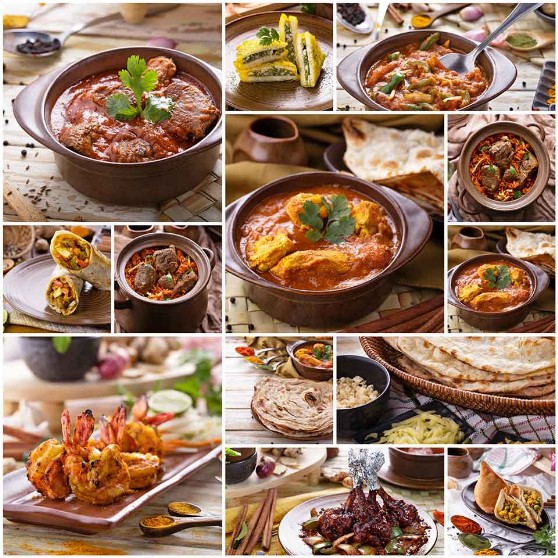
Dining
India is a gourmet’s paradise. Several of its restaurant have become legends, even overseas, and Indian food has found a very wide acceptability worldwide. Understanding the kind of Indian food you wish to taste may pose a difficult choice. Each region has its own distinctive cuisine with its own flavours and spices. The cuisines of North India is generally gravied – with the exception of the popular tandoori (barbecue) range – and is rich and flavoursome, and is usually eaten with a variety of unleavened breads called rotis. That of the south is lighter by far, usually vegetarian, and there is a lot of emphasis on lentils, yoghurt and rice. The cuisine of Goa is hot, and sea food is a specialty. Food from Lucknow and Hyderabad has attained an excellence in its experimentation with different means of preparation and flavouring. East Indians love fish, and eat a light diet. Savoury snacks from different regions also give you a piquant taste of India.
Drinking Water
In standard hotels, drinking water is generally mineral water in sealed bottles, and available in your room and restaurants. While travelling to different places you may want to carry a stock of mineral water for your journey or when traveling to some of the smaller resorts. However, it is easily available at most of the places.
Transport
Air: India had the world's third-largest civil aviation market in 2017, with the number of passengers growing at an average annual rate of 16%. Indigo, Spice Jet, Go First, Vistara, Air India, are the major (including low cost) carriers; Air Asia & Akasa Air are slowly increasing their network. They normally operating with Boeing 737, Airbus 320, ATR 42/72 etc.
Rail: One of the largest railway networks in the world (23 million passengers daily), the Indian Railways run a number of trains that are meant to facilitate tourists. These include the grand Palace on Wheels with its magnificent saloons, the high speed Shatabdi and Taj express trains, the Rajdhani connections from Delhi to Calcutta and Bombay, and a number of hill ‘toy’ trains, among others.
Road: Tourists can hire air-conditioned sedans/ limousines/ vans or coaches at any principal city or tourists destination by the day or for longer periods. Ordinary taxis are available in all metros; in smaller towns three-wheeler auto rickshaws and cycle or horse carriage can still be used. Kolkata city has an underground metro as well few routes of tramway still running. There are metro networks in major cities.
